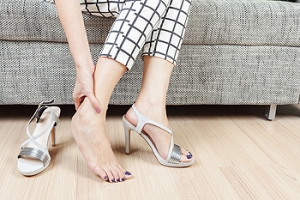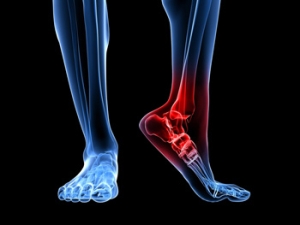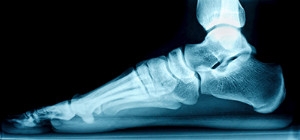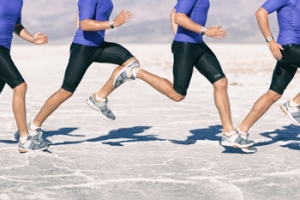
The Harm in High Heels
 High heels are a wardrobe staple for many, however, wearing high heels can have serious consequences for foot health. A study on foot and ankle injuries in the U.S. found that between 2002 and 2012, U.S. emergency rooms treated 123,355 high heel-related injuries. Strains and sprains of the foot and ankle were the most common of these injuries, and about 20% of them involved broken bones. Another study, this time looking at South Korean flight attendants who were required to wear high heels daily for work, found that their balance decreased over time due to a loss of strength in the muscles and tendons that support the front-to-back movement of the foot. If you do wear high heels, it is recommended that you wear them less frequently, and that you give your feet a break by taking the high heels off to stretch your feet and ankles or by switching to running shoes. For more information on the connection between footwear and foot health, speak with a podiatrist today.
High heels are a wardrobe staple for many, however, wearing high heels can have serious consequences for foot health. A study on foot and ankle injuries in the U.S. found that between 2002 and 2012, U.S. emergency rooms treated 123,355 high heel-related injuries. Strains and sprains of the foot and ankle were the most common of these injuries, and about 20% of them involved broken bones. Another study, this time looking at South Korean flight attendants who were required to wear high heels daily for work, found that their balance decreased over time due to a loss of strength in the muscles and tendons that support the front-to-back movement of the foot. If you do wear high heels, it is recommended that you wear them less frequently, and that you give your feet a break by taking the high heels off to stretch your feet and ankles or by switching to running shoes. For more information on the connection between footwear and foot health, speak with a podiatrist today.
High heels have a history of causing foot and ankle problems. If you have any concerns about your feet or ankles, contact Corinne R. Kauderer, DPM from Dyker Heights Foot & Ankle. Our doctor can provide the care you need to keep you pain-free and on your feet.
Effects of High Heels on the Feet
High heels are popular shoes among women because of their many styles and societal appeal. Despite this, high heels can still cause many health problems if worn too frequently.
Which Parts of My Body Will Be Affected by High Heels?
- Ankle Joints
- Achilles Tendon – May shorten and stiffen with prolonged wear
- Balls of the Feet
- Knees – Heels cause the knees to bend constantly, creating stress on them
- Back – They decrease the spine’s ability to absorb shock, which may lead to back pain. The vertebrae of the lower back may compress.
What Kinds of Foot Problems Can Develop from Wearing High Heels?
- Corns
- Calluses
- Hammertoe
- Bunions
- Morton’s Neuroma
- Plantar Fasciitis
How Can I Still Wear High Heels and Maintain Foot Health?
If you want to wear high heeled shoes, make sure that you are not wearing them every day, as this will help prevent long term physical problems. Try wearing thicker heels as opposed to stilettos to distribute weight more evenly across the feet. Always make sure you are wearing the proper shoes for the right occasion, such as sneakers for exercising. If you walk to work, try carrying your heels with you and changing into them once you arrive at work. Adding inserts to your heels can help cushion your feet and absorb shock. Full foot inserts or metatarsal pads are available.
If you have any questions please feel free to contact one of our offices located in Brooklyn, NY and Old Bridge, NJ . We offer the newest diagnostic and treatment technologies for all your foot and ankle needs.
Effect of High Heels on the Feet
For hundreds of years, women have been wearing various kinds of high heels for aesthetic reasons. Women who wear high heels appear to be taller and have longer and thinner legs, and the wearer’s gait and posture changes. Though high heels have had an association with femininity and have kept them popular over the years, there are definite health problems caused by wearing them too frequently.
The motion of the ankle joints is limited when heels are worn. The ankle joint is very important to the body when it comes to walking. Because of their location, these joints have a great deal of weight put on them. Thus, it is very important to keep them as healthy as possible. The Achilles tendon is the main tendon in the ankle. Wearing high heels too often, studies have shown, can cause the calf muscle and Achilles tendon to shorten and stiffen. This can cause problems when shoes without heels are worn.
By putting a great deal of pressure on the ball of the foot and by forcing the toes into a small toe box, high heels can cause or may worsen many foot problems. These include corns, hammertoe, bunions, Morton’s neuroma and plantar fasciitis.
Not only does wearing high heels regularly have negative effects on the feet, the rest of the body can suffer as well. The knees, one of the most important joints in the entire body, can be affected by wearing high heels. High heels can cause the knees to stay bent all the time. Also, it can cause them to bend slightly inward as well. Doctors believe that women can suffer from osteoarthritis later in life because of constantly walking like in high heels. By limiting the natural motion of the foot during walking, high heels also cause an increased in stress on the knees.
Similarly, high heels can cause the back to go out of alignment. If high heels are worn constantly, the spine’s ability to absorb shock can cause continued back pain. They can compress the vertebrae of the lower back, and can overuse the back muscles.
However, this is not to say that high heels can never be worn. If worn occasionally and not often, they will not cause serious problems. They should not be worn every day. It’s important to wear them modestly to avoid the long-term physical health problems of the feet, knees, ankles, and back mentioned above.
Sever’s Disease: Not as Scary as It Sounds
 If your child complains of foot pain and you take them to the podiatrist, hearing that they have been diagnosed with Sever’s disease can be frightening. Fortunately, Sever’s disease, or calcaneal apophysitis as it is sometimes called, sounds a lot worse than it really is. Rather than being an actual disease, Sever’s disease is an overuse injury. Simply put, it is an injury to the growth plate of the heel bone. Children’s heel bones are typically not done developing until the age of 14. As your child grows, new bone is forming in the heel’s growth plate, a weak area located at the back of the heel. Repetitive stress on this growth plate from participating in sports and activities that involve running and pounding on a hard surface, can cause inflammation and muscle strain. Your child may complain of pain in the back or bottom of the foot, fatigue, or pain while walking or doing sports. With the professional treatment, your child will soon be back on their feet. If you suspect that your child may have Sever’s disease, please visit a podiatrist for a proper diagnosis and treatment.
If your child complains of foot pain and you take them to the podiatrist, hearing that they have been diagnosed with Sever’s disease can be frightening. Fortunately, Sever’s disease, or calcaneal apophysitis as it is sometimes called, sounds a lot worse than it really is. Rather than being an actual disease, Sever’s disease is an overuse injury. Simply put, it is an injury to the growth plate of the heel bone. Children’s heel bones are typically not done developing until the age of 14. As your child grows, new bone is forming in the heel’s growth plate, a weak area located at the back of the heel. Repetitive stress on this growth plate from participating in sports and activities that involve running and pounding on a hard surface, can cause inflammation and muscle strain. Your child may complain of pain in the back or bottom of the foot, fatigue, or pain while walking or doing sports. With the professional treatment, your child will soon be back on their feet. If you suspect that your child may have Sever’s disease, please visit a podiatrist for a proper diagnosis and treatment.
Sever's disease often occurs in children and teens. If your child is experiencing foot or ankle pain, see Corinne R. Kauderer, DPM from Dyker Heights Foot & Ankle. Our doctor can treat your child’s foot and ankle needs.
Sever’s Disease
Sever’s disease is also known as calcaneal apophysitis, which is a medical condition that causes heel pain I none or both feet. The disease is known to affect children between the ages of 8 and 14.
Sever’s disease occurs when part of the child’s heel known as the growth plate (calcaneal epiphysis) is attached to the Achilles tendon. This area can suffer injury when the muscles and tendons of the growing foot do not keep pace with bone growth. Therefore, the constant pain which one experiences at the back of the heel will make the child unable to put any weight on the heel. The child is then forced to walk on their toes.
Symptoms
Acute pain – Pain associated with Sever’s disease is usually felt in the heel when the child engages in physical activity such as walking, jumping and or running.
Highly active – Children who are very active are among the most susceptible in experiencing Sever’s disease, because of the stress and tension placed on their feet.
If you have any questions, please feel free to contact one of our offices located in Brooklyn, NY and Old Bridge, NJ . We offer the newest diagnostic and treatment technologies for all your foot and ankle injuries.
Sever's Disease
Sever’s disease, also known as calcaneal apophysitis is a common bone disorder that occurs during childhood. The disease is defined as an inflammation of the growth plate in the heel. When a child has a growth spurt, his heel bone grows faster than the muscles, tendons, and ligaments in his leg. This disease is a result of overuse. The people who are most likely to be affected by this disease are children who are in a growth spurt, especially boys who are from the ages of 5 to 13 years old. 60% of children with Sever’s disease have both heels involved.
Symptoms of this disease are heel pain that intensifies during running and jumping activities. The pain is typically localized to the posterior part of the heel. Symptoms may be severe, and they can easily interfere with daily activities. Children who play soccer, baseball, and basketball are more likely to develop Sever’s disease.
Your doctor will diagnose your child based on his or her symptoms, x-rays are generally not helpful in diagnosing this disease. Your doctor may examine both heels and ask your child questions about his or her activity level in sports. Your doctor may then use the squeeze test on your child’s heel to see if there is any pain. Nevertheless, some doctors might still use x-rays to rule out any other issues such as fractures, infections, and tumors.
Sever’s disease can be prevented by maintaining good flexibility while your child is growing. Another prevention method is to wear good-quality shoes that have firm support and a shock-absorbent sole. Sever’s disease can be treated by ceasing any activity that causes heel pain. You should apply ice to the injured heel for 20 minutes 3 times a day. Additionally, orthotics should be used for children who have high arches, flat feet, or bowed legs.
If you suspect your child has Sever’s disease, you should make an appointment with your podiatrist to have his or her foot examined. Your doctor may recommend nonsteroidal anti-inflammatory drugs (NSAIDs), such as ibuprofen or naproxen to relieve pain. In more severe cases, your child may need a cast to rest his or her heel. Fortunately, Sever’s disease does not cause long-term foot problems. After treatment, your child should start to feel better within two weeks to two months.
What Are Flexible Flat Feet?
 The term “flexible flat feet” refers to one of the most common types of flat feet. People with this condition have no visible arches when they are standing, but do have visible arches when they aren’t. This condition usually begins in childhood and continues into the adult years, getting progressively worse over time. The tendons and ligaments of the arch may eventually stretch or tear, becoming inflamed and painful. The typical symptoms of flexible flat feet include pain in the heel, arch, or ankle, feet that roll inward when you walk, pain along the shin, and a general aching or tiredness in the feet or legs. There are a variety of treatment options available for this condition, such as orthotic devices, or activity and shoe modifications. For more information about flexible flat feet, please consult with a podiatrist.
The term “flexible flat feet” refers to one of the most common types of flat feet. People with this condition have no visible arches when they are standing, but do have visible arches when they aren’t. This condition usually begins in childhood and continues into the adult years, getting progressively worse over time. The tendons and ligaments of the arch may eventually stretch or tear, becoming inflamed and painful. The typical symptoms of flexible flat feet include pain in the heel, arch, or ankle, feet that roll inward when you walk, pain along the shin, and a general aching or tiredness in the feet or legs. There are a variety of treatment options available for this condition, such as orthotic devices, or activity and shoe modifications. For more information about flexible flat feet, please consult with a podiatrist.
Flatfoot is a condition many people suffer from. If you have flat feet, contact Corinne R. Kauderer, DPM from Dyker Heights Foot & Ankle. Our doctor will treat your foot and ankle needs.
What Are Flat Feet?
Flatfoot is a condition in which the arch of the foot is depressed and the sole of the foot is almost completely in contact with the ground. About 20-30% of the population generally has flat feet because their arches never formed during growth.
Conditions & Problems:
Having flat feet makes it difficult to run or walk because of the stress placed on the ankles.
Alignment – The general alignment of your legs can be disrupted, because the ankles move inward which can cause major discomfort.
Knees – If you have complications with your knees, flat feet can be a contributor to arthritis in that area.
Symptoms
- Pain around the heel or arch area
- Trouble standing on the tip toe
- Swelling around the inside of the ankle
- Flat look to one or both feet
- Having your shoes feel uneven when worn
Treatment
If you are experiencing pain and stress on the foot you may weaken the posterior tibial tendon, which runs around the inside of the ankle.
If you have any questions please feel free to contact one of our offices located in Brooklyn, NY and Old Bridge, NJ . We offer the newest diagnostic and treatment technologies for all your foot and ankle needs.
Flat Feet
Flatfoot is a condition that occurs when the arches on the foot are flattened, which allows the soles of the feet to touch the floor. Flatfoot is a common condition and it is usually painless.
Throughout childhood, most people begin to develop arches in their feet, however, some do not. Those who do not develop arches are left with flatfoot. The pain associated with flat feet is usually at its worse when engaging in activity. Another symptom that may occur with those who have this condition is swelling along the inside of the ankle.
It is also possible to have flexible flatfoot. Flexible flatfoot occurs when the arch is visible while sitting or standing on the tiptoes, but it disappears when standing. People who have flexible flatfoot are often children and most outgrow it without any problems.
There are some risk factors that may make you more likely to develop flatfoot. Those who have diabetes and rheumatoid arthritis have an increased risk of flatfoot development. Other factors include aging and obesity.
Diagnosis for flat feet is usually done by a series of tests by your podiatrist. Your podiatrist will typically try an x-ray, CT scan, ultrasound, or MRI on the feet. Treatment is usually not necessary for flat foot unless it causes pain. However, therapy is often used for those who experience pain in their flat feet. Some other suggested treatment options are arch supports, stretching exercises, and supportive shoes.
Why Biomechanics Are Important
 In podiatry, biomechanics involves assessing the structure, alignment and function of the feet. The foot provides us with the ability to walk upright and has developed to adapt to whatever surfaces we walk on. Because the average person takes between 5,000 and 18,000 steps in a single day, the foot can experience stress from repetitiveness, resulting in injury. While options such as orthotics can help prevent injury, paying special attention to the strength and flexibility of the feet allow their function to improve. Therefore, if you are actively on your feet, make sure to consult with a podiatrist to help find any predisposed issues.
In podiatry, biomechanics involves assessing the structure, alignment and function of the feet. The foot provides us with the ability to walk upright and has developed to adapt to whatever surfaces we walk on. Because the average person takes between 5,000 and 18,000 steps in a single day, the foot can experience stress from repetitiveness, resulting in injury. While options such as orthotics can help prevent injury, paying special attention to the strength and flexibility of the feet allow their function to improve. Therefore, if you are actively on your feet, make sure to consult with a podiatrist to help find any predisposed issues.
If you have any concerns about your feet, contact Corinne R. Kauderer, DPM from Dyker Heights Foot & Ankle. Our doctor can provide the care you need to keep you pain-free and on your feet.
Biomechanics in Podiatry
Podiatric biomechanics is a particular sector of specialty podiatry with licensed practitioners who are trained to diagnose and treat conditions affecting the foot, ankle and lower leg. Biomechanics deals with the forces that act against the body, causing an interference with the biological structures. It focuses on the movement of the ankle, the foot and the forces that interact with them.
A History of Biomechanics
- Biomechanics dates back to the BC era in Egypt where evidence of professional foot care has been recorded.
- In 1974, biomechanics gained a higher profile from the studies of Merton Root, who claimed that by changing or controlling the forces between the ankle and the foot, corrections or conditions could be implemented to gain strength and coordination in the area.
Modern technological improvements are based on past theories and therapeutic processes that provide a better understanding of podiatric concepts for biomechanics. Computers can provide accurate information about the forces and patterns of the feet and lower legs.
Understanding biomechanics of the feet can help improve and eliminate pain, stopping further stress to the foot.
If you have any questions please feel free to contact one of our offices located in Brooklyn, NY and Old Bridge, NJ . We offer the newest diagnostic and treatment technologies for all your foot and ankle needs.
The Importance of Biomechanics in Podiatry
Biomechanics and its related study deal with the forces that act against the body and affect things like our movement. In podiatry, biomechanics are studied to determine the movement of the ankle, toes, and the foot, as well as the forces that impact them. Podiatrists who train in this specialty are able to effectively diagnose and treat conditions that affect people’s everyday movement.
Regardless of your lifestyle, age, or any other factors, many people experience foot problems throughout their lives. Twists and turns, improper balance, and added weight are just a few of the things that can add stress to the feet. These issues can also limit our bodies’ mobility that we often take for granted. Pain in the feet and ankles can also trickle up towards the lower legs, knees, hip, and even back area. This affects the way you move around on a daily basis.
Biomechanics and its related study deal with forces that act against the body and affect things like our movement. In podiatry, biomechanics are studied to determine the movement of the ankle, toes, and the foot, as well as the forces that impact them. Podiatrists who train in this specialty are able to effectively diagnose and treat conditions that affect people’s everyday movement.
Regardless of your lifestyle, age, or any other factors, many people experience foot problems throughout their lives. Twists and turns, improper balance, and added weight are just a few of the things that can add stress to the feet. These issues can also limit our bodies’ mobility that we often take for granted. Pain in the feet and ankles can also trickle up towards the lower legs, knees, hip, and even back area. This affects the way you move around on a daily basis.
The history of studying biomechanics dates back to ancient Egypt at around 3000 B.C., where evidence of professional foot care has been recorded. Throughout the centuries, advances in technology, science, and an understanding of the human body led to more accurate diagnosis of conditions such as corns for example. In 1974, biomechanics garnered a large audience when Merton Root founded Root Lab to make custom orthotics. He proposed that corrections of certain conditions could be implemented to gain strength and coordination in the area. Due to his research, we still use his basic principle of foot orthotics to this day.
As technology has improved, so have the therapeutic processes that allow us to correct deficiencies in our natural biomechanics. Computers can now provide accurate readings of the forces, movements, and patterns of the foot and lower leg. Critical treatment options can be provided to patients now who suffer from problems that cause their biomechanics to not function naturally. The best results are now possible thanks to 3D modeling and computing technologies that can take readings and also map out what treatment will do to the affected areas.
These advanced corrective methods were able to come to light thanks to an increase in both the technologies surrounding biomechanics and also the knowledge of how they work naturally. For example, shoe orthotics are able to treat walking inabilities by realigning the posture deviations in patients caused by hip or back problems. Understanding foot biomechanics can help improve movement and eliminate pain, stopping further stress to the foot. Speak with your podiatrist if you have any of these problems.
Tarsal Tunnel Syndrome
Tarsal tunnel syndrome is a condition in which there is a compression of the posterior tibial nerve. The posterior tibial nerve runs along the inside of the ankle into the foot. Tarsal tunnel syndrome is named for the tarsal tunnel, which is a thin space along the inside of the ankle beside the ankle bones. This space contains various nerves, arteries, and tendons, and includes the posterior tibial nerve. The tibial nerve is the peripheral nerve in the leg responsible for sensation and movement of the foot and calf muscles. In tarsal tunnel syndrome the tibial nerve is compressed, causing tingling or burning, numbness, and pain.
Common causes of tarsal tunnel syndrome involve pressure or an injury. Injuries that produce inflammation and swelling in or around the tunnel may place pressure on the posterior tibial nerve. Direct pressure on the tibial nerve for an extended period of time, sometimes caused by other body structures close by or trauma to the tibial nerve, can result in tarsal tunnel syndrome. Diseases that damage nerves, such as diabetes or arthritis, may cause tarsal tunnel syndrome. Those with flat feet are at risk for developing the condition, as the extra pressure and strain placed on the foot may compress the posterior tibial nerve.
Feeling different sensations in the foot at different times is a common symptom of tarsal tunnel syndrome. An afflicted person may experience pain, tingling, burning or other unusual sensations in the foot of the affected leg. Symptoms are primarily felt on bottom of the foot and/or the inside of the ankle. Symptoms can appear suddenly and may occur due to overuse of the foot.
To diagnose tarsal tunnel syndrome, your podiatrist may examine the foot and tap the posterior tibial nerve to see if symptoms surface. He or she may also order an MRI to determine if a mass is present.
Treating tarsal tunnel syndrome will depend on the decision of your podiatrist. Multiple options are available, however, and can include rest, ice, immobilization, oral medications such as anti-inflammatory drugs (NSAIDS), physical therapy, injection therapy, orthotics, supportive shoes, braces, and surgery.
Roomier Shoes may Help Hammertoe
 Hammertoe is a common deformity of the joints in which a person's toe is bent into a claw-like position. Usually this will affect the second toe, but can occur in the third fourth and fifth toe too. It is typically caused by wearing ill-fitting shoes with high heels and little room for the toes to move. Hammertoe typically starts with mild deformities which progress over time. Left untreated, hammertoes may require surgical intervention. Fortunately, hammertoes may be prevented entirely or have their progression slowed by wearing appropriate footwear. It is suggested to look for shoes with plenty of room in the toe area. Avoid high heels and shoes with pointed toes. A podiatrist can help you find the best footwear to prevent or mitigate the progression of hammertoe. A podiatrist may also prescribe pads, orthotic devices, or medications, or may even recommend surgery in more severe cases.
Hammertoe is a common deformity of the joints in which a person's toe is bent into a claw-like position. Usually this will affect the second toe, but can occur in the third fourth and fifth toe too. It is typically caused by wearing ill-fitting shoes with high heels and little room for the toes to move. Hammertoe typically starts with mild deformities which progress over time. Left untreated, hammertoes may require surgical intervention. Fortunately, hammertoes may be prevented entirely or have their progression slowed by wearing appropriate footwear. It is suggested to look for shoes with plenty of room in the toe area. Avoid high heels and shoes with pointed toes. A podiatrist can help you find the best footwear to prevent or mitigate the progression of hammertoe. A podiatrist may also prescribe pads, orthotic devices, or medications, or may even recommend surgery in more severe cases.
Hammertoe
Hammertoes can be a painful condition to live with. For more information, contact Corinne R. Kauderer, DPM from Dyker Heights Foot & Ankle. Our doctor will answer any of your foot- and ankle-related questions.
Hammertoe is a foot deformity that affects the joints of the second, third, fourth, or fifth toes of your feet. It is a painful foot condition in which these toes curl and arch up, which can often lead to pain when wearing footwear.
Symptoms
- Pain in the affected toes
- Development of corns or calluses due to friction
- Inflammation
- Redness
- Contracture of the toes
Causes
Genetics – People who are genetically predisposed to hammertoe are often more susceptible
Arthritis – Because arthritis affects the joints in your toes, further deformities stemming from arthritis can occur
Trauma – Direct trauma to the toes could potentially lead to hammertoe
Ill-fitting shoes – Undue pressure on the front of the toes from ill-fitting shoes can potentially lead to the development of hammertoe
Treatment
Orthotics – Custom made inserts can be used to help relieve pressure placed on the toes and therefore relieve some of the pain associated with it
Medications – Oral medications such as anti-inflammatories or NSAIDs could be used to treat the pain and inflammation hammertoes causes. Injections of corticosteroids are also sometimes used
Surgery – In more severe cases where the hammertoes have become more rigid, foot surgery is a potential option
If you have any questions please contact one of our offices located in Brooklyn, NY and Old Bridge, NJ . We offer the newest diagnostic and treatment technologies for all your foot and ankle needs.












